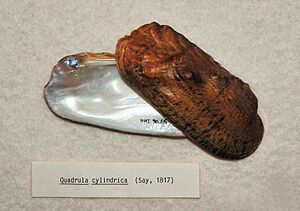Rabbitsfoot facts for kids
Quick facts for kids Rabbitsfoot |
|
|---|---|
 |
|
| Museum specimen | |
| Conservation status | |
| Scientific classification | |
| Genus: |
Theliderma
|
| Species: |
cylindrica
|
| Synonyms | |
|
List
Quadrula cylindrica (Say, 1817)
Quadrula cylindrica subsp. cylindrica (Say, 1817) Quadrula cylindrica subsp. strigillata (B.H. Wright, 1898) Unio cylindricus Say, 1817 Unio naviformis Lamarck, 1819 Unio solenoides Rafinesque, 1820 Unio solenoides subsp. nodosa Rafinesque, 1820 Unio solenoides subsp. interrupta Rafinesque, 1820 Unio cylindricus subsp. strigillatus B.H. Wright, 1898 Unio cilindricus subsp. propetipicus de Gregorio, 1914 Unio cilindricus subsp. acrispatus de Gregorio, 1914 |
|
The rabbitsfoot (Theliderma cylindrica) is a special type of freshwater mussel. It is an animal that lives in water and has two shells, like a clam. These animals are also called bivalve mollusks. They belong to a family known as Unionidae, or river mussels.
This mussel is naturally found in the United States. It lives in the rivers and streams that flow into the Ohio River and the Great Lakes. Sadly, the rabbitsfoot has disappeared from more than half of the places it used to live.
Types of Rabbitsfoot Mussels
Scientists have described two main types, or subspecies, of the rabbitsfoot mussel. It's not fully clear if these are truly different kinds or just variations based on where they live. Recent studies suggest they might be more similar than once thought.
- Theliderma cylindrica cylindrica (Say, 1817)
- Theliderma cylindrica strigillata (Wright, 1898) — This type is also known as the Rough rabbitsfoot. It is found only in the upper parts of the Tennessee River.
Protecting the Rabbitsfoot Mussel
The rabbitsfoot mussel needs our help to survive. Both types of rabbitsfoot mussels are protected by law in the United States.
- The Theliderma cylindrica cylindrica has been listed as a "threatened species" since 2013. This means it is likely to become endangered in the near future.
- The Theliderma cylindrica strigillata has been listed as an "endangered species" since 1997. This means it is in danger of disappearing forever.
Protecting these mussels helps keep our rivers and lakes healthy for everyone.
Images for kids
See Also





